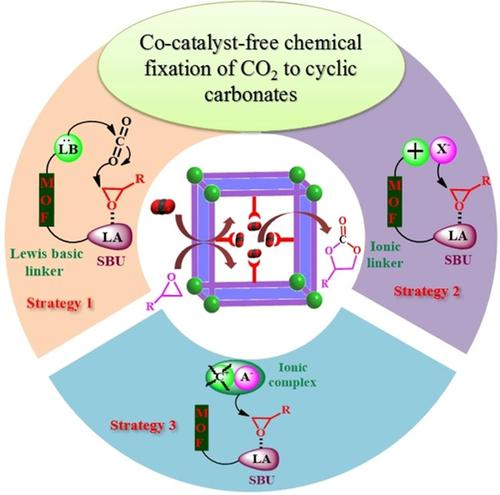当前位置:
X-MOL 学术
›
Chem. Asian J.
›
论文详情
Our official English website, www.x-mol.net, welcomes your feedback! (Note: you will need to create a separate account there.)
Co-Catalyst-Free Chemical Fixation of CO2 into Cyclic Carbonates by using Metal-Organic Frameworks as Efficient Heterogeneous Catalysts.
Chemistry - An Asian Journal ( IF 4.1 ) Pub Date : 2020-06-11 , DOI: 10.1002/asia.202000424 Sandeep Singh Dhankhar 1 , Bharat Ugale 1 , C M Nagaraja 1
Chemistry - An Asian Journal ( IF 4.1 ) Pub Date : 2020-06-11 , DOI: 10.1002/asia.202000424 Sandeep Singh Dhankhar 1 , Bharat Ugale 1 , C M Nagaraja 1
Affiliation

|
The concentration of carbon dioxide (CO2) in the atmosphere is increasing at an alarming rate resulting in undesirable environmental issues. To mitigate this growing concentration of CO2, selective carbon capture and storage/sequestration (CCS) are being investigated intensively. However, CCS technology is considered as an expensive and energy‐intensive process. In this context, selective carbon capture and utilization (CCU) as a C1 feedstock to synthesize value‐added chemicals and fuels is a promising step towards lowering the concentration of the atmospheric CO2 and for the production of high‐value chemicals. Towards this direction, several strategies have been developed to convert CO2, a Greenhouse gas (GHG) into useful chemicals by forming C−N, C−O, C−C, and C−H bonds. Among the various CO2 functionalization processes known, the cycloaddition of CO2 to epoxides has gained considerable interest owing to its 100% atom‐economic nature producing cyclic carbonates or polycarbonates in high yield and selectivity. Among the various classes of catalysts studied for cycloaddition of CO2 to cyclic carbonates, porous metal‐organic frameworks (MOFs) have gained a special interest due to their modular nature facilitating the introduction of a high density of Lewis acidic (LA) and CO2‐philic Lewis basic (LB) functionalities. However, most of the MOF‐based catalysts reported for cycloaddition of CO2 to respective cyclic carbonates in high yields require additional co‐catalyst, say tetra‐n‐butylammonium bromide (TBAB). On the contrary, the co‐catalyst‐free conversion of CO2 using rationally designed MOFs composed of both LA and LB sites is relatively less studied. In this review, we provide a comprehensive account of the research progress in the design of MOF based catalysts for environment‐friendly, co‐catalyst‐free fixation of CO2 into cyclic carbonates.
中文翻译:

通过使用金属有机骨架作为高效多相催化剂,将无CO2的无助催化剂化学固定在环状碳酸酯中。
大气中二氧化碳(CO 2)的浓度以惊人的速度增加,从而导致不良的环境问题。为了减轻这种不断增长的CO 2浓度,正在对选择性碳捕获和储存/封存(CCS)进行深入研究。但是,CCS技术被认为是昂贵且耗能的过程。在这种情况下,选择性碳捕获和利用(CCU)作为C1原料来合成增值化学品和燃料是降低大气中CO 2浓度和生产高价值化学品的有希望的一步。朝着这个方向,已经开发了几种转化CO 2的策略。,通过形成CN,OC,CC和CH键将温室气体(GHG)转化为有用的化学物质。在已知的各种CO 2官能化方法中,由于将CO 2环化成环氧化物,由于其100%的原子经济性质,可以高产率和高选择性地生产环状碳酸酯或聚碳酸酯,因此引起了极大的兴趣。在研究用于将CO 2环加成成环状碳酸酯的各种催化剂中,多孔金属有机骨架(MOF)由于具有模块化性质,因而有助于引入高密度的路易斯酸(LA)和CO 2而引起了特别的兴趣。亲爱的Lewis基本(LB)功能。但是,大多数基于MOF的催化剂都报告了CO 2的环加成反应高产率地制备相应的环状碳酸酯需要额外的助催化剂,例如四正丁基溴化铵(TBAB)。相反,使用由LA和LB位置组成的合理设计的MOF进行的无助催化剂的CO 2转化研究相对较少。在这篇综述中,我们全面介绍了基于MOF的催化剂设计的研究进展,该催化剂用于将CO 2环保,无助催化剂固定到环状碳酸酯中。
更新日期:2020-08-18
中文翻译:

通过使用金属有机骨架作为高效多相催化剂,将无CO2的无助催化剂化学固定在环状碳酸酯中。
大气中二氧化碳(CO 2)的浓度以惊人的速度增加,从而导致不良的环境问题。为了减轻这种不断增长的CO 2浓度,正在对选择性碳捕获和储存/封存(CCS)进行深入研究。但是,CCS技术被认为是昂贵且耗能的过程。在这种情况下,选择性碳捕获和利用(CCU)作为C1原料来合成增值化学品和燃料是降低大气中CO 2浓度和生产高价值化学品的有希望的一步。朝着这个方向,已经开发了几种转化CO 2的策略。,通过形成CN,OC,CC和CH键将温室气体(GHG)转化为有用的化学物质。在已知的各种CO 2官能化方法中,由于将CO 2环化成环氧化物,由于其100%的原子经济性质,可以高产率和高选择性地生产环状碳酸酯或聚碳酸酯,因此引起了极大的兴趣。在研究用于将CO 2环加成成环状碳酸酯的各种催化剂中,多孔金属有机骨架(MOF)由于具有模块化性质,因而有助于引入高密度的路易斯酸(LA)和CO 2而引起了特别的兴趣。亲爱的Lewis基本(LB)功能。但是,大多数基于MOF的催化剂都报告了CO 2的环加成反应高产率地制备相应的环状碳酸酯需要额外的助催化剂,例如四正丁基溴化铵(TBAB)。相反,使用由LA和LB位置组成的合理设计的MOF进行的无助催化剂的CO 2转化研究相对较少。在这篇综述中,我们全面介绍了基于MOF的催化剂设计的研究进展,该催化剂用于将CO 2环保,无助催化剂固定到环状碳酸酯中。



























 京公网安备 11010802027423号
京公网安备 11010802027423号